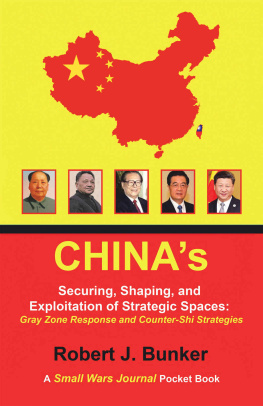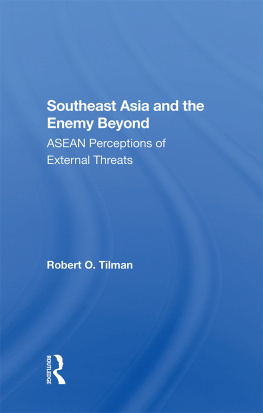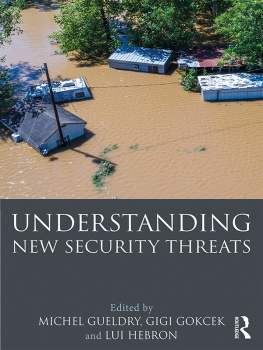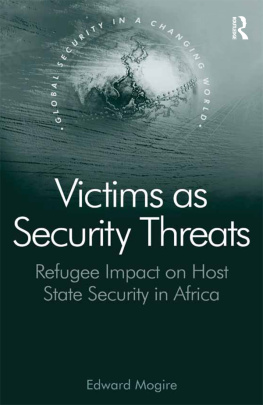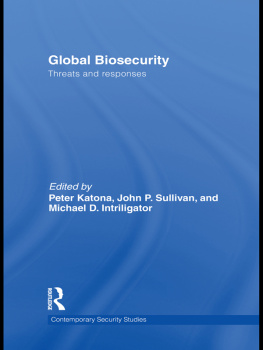Non-State Threats and Future Wars
Also in this series
Deterrence in the 21st Century
edited by Max E. Manwaring
Peace Operations Between War and Peace
edited by Erwin A. Schmidl
Towards Responsibility in the New World Disorder:
Challenges and Lessons of Peace Operations
edited by Max G. Manwaring and John T. Fishel
Warriors in Peacetime:
The Military and Democracy in Latin America
edited by Gabriel Marcella
Defence and the Media in Time of Limited War
edited by Peter R. Young
NON-STATE THREATS AND FUTURE WARS
Editor
ROBERT J. BUNKER
First published in 2003 in Great Britain by
FRANK CASS AND COMPANY LIMITED
2 Park Square, Milton Park,
Abingdon, Oxon, OX14 4RN
and in the United States of America by
FRANK CASS
270 Madison Ave,
New York NY 10016
Transferred to Digital Printing 2005
Website: www.frankcass.com
Copyright 2003 Frank Cass & Co. Ltd
British Library Cataloguing in Publication Data
Non-state threats and future wars
1.National security 2.Military policy 3.Subversive activities 4.Crime prevention 5.Terrorism Prevention
I.Bunker, Robert J.
355 .03
ISBN 07146 5374 8 (cloth)
ISBN 07146 8308 6 (paper)
Library of Congress Cataloging-in-Publication Data
Non-state threats and future wars / editor, Robert J. Bunker,
p. cm.
First appeared in a special issue ... of Small wars & insurgencies ISSN 0959-2318) 13/2 (Summer 2002) published by Frank Cass Verso t.p.
Includes bibliographical references and index.
ISBN 0-7146-5374-8 ISBN 0-7146-8308-6 (pbk.)
1. National security. 2. Non-governmental organizations 3. Military art and science History 20th century. 4. Military art and science History 21st century. 5. Terrorism Prevention. 6. Subversive activities. 7. Crime prevention. 8. World politics 1989- I. Bunker, Robert J. II. Small wars & insurgencies.
UA10.5 .N65 2002
355 .033 dc21 2002015229
This group of studies first appeared in a Special Issue on Non-State Threats and Future Wars of Small Wars & Insurgencies (ISSN 0959-2318) 13/2 (Summer 2002) published by Frank Cass
All rights reserved. No part of this publication may be reproduced, stored in or introduced into a retrieval system, or transmitted in any form, or by any means, electronic, mechanical, photocopying, recording or otherwise without the prior written permission of the publishers of this book.
Preface: New Context, Smart Enemies
Phil Williams
The decade after the end of the Cold War and the collapse of the Soviet Union was marked by prosperity and optimism, especially in the United States. A contagious economic crisis in Asia was contained and United States hegemony was seen (in the United States at least) as providing the basis for a new peaceful and stable international order. Global governance mechanisms, underpinned by United States military and economic dominance, appeared to provide appropriate responses to new international challenges. The United States military worried about an emergent China and a resurgent Russia, but these were essentially long term challenges that did little to disturb the existing harmony. Terrorism and organized crime were regarded as nuisances, part of a new security agenda that was far less challenging and dangerous than the threat that had been posed by Soviet military power and ideological ambitions.
The optimism of the 1990s was based in many respects on illusion: the Clinton administration defined United States security largely in terms of maintaining prosperity. The impact of organized crime and corruption on states in transition was understood conceptually, but was largely ignored in the formulation and implementation of United States policy towards Russia while the challenge posed by Al-Qaeda and international terrorism more generally was treated as a sideshow requiring some attention but no sustained effort or resources. Yet the illusion continued in the first eight months of the Bush administration. While ballistic missile defense was elevated in importance, for the most part, continuity of assumption and policy was the order of the day. Asymmetrical threats were regarded as something to be concerned about but, implicitly at least, were deemed preferable to symmetrical threats.
These illusions were shattered on 11 September 2001. The Al-Qaeda attacks on the World Trade Center and the Pentagon were a prime example of asymmetrical warfare 19 men, (albeit with support from a larger network) were able to cause the deaths of around 3,000 people as well as enormous economic and psychological damage. In effect, the attacks marked the end of a period of optimism and the beginning of a recognition that the world of the twenty-first century was not as readily amenable to American power and influence as had been assumed.
Against that background, this work takes on particular importance. It reflects the fact that the world has changed fundamentally and that there is a new security environment populated by smart enemies. The United States can no longer take security for granted let alone reduce it to economic prosperity. Indeed, the challenge of this new century is one that transcends Al-Qaeda, even though the network, in spite of US military success in Afghanistan, is likely to remain for some time the most immediate and serious threat to United States national security. The challenge is to establish a degree of governance in a world of growing disorder. It is a formidable challenge, reflecting new complexities in global politics that call many of the existing assumptions into question, and demanding innovative and imaginative responses based on new organizational structures as well as new security mechanisms and instruments. Perhaps, most of all, it requires a sensitivity to enemies who make up for their lack of raw power in their capacity to fight smart and sometimes to avoid fighting at all, preferring corruption and co-option to confrontation and conflict.
There are several characteristics of this new environment that need to be taken into account as policy-makers struggle to establish order out of disorder. These are not ephemeral or temporary characteristics, but emergent realities that first have to be understood and appreciated fully and then incorporated into a new framework for policy and strategy.
The first of the new realities is that international security has become much more complex than in the past. Attention can no longer be focused solely on states; it is also necessary to contend with a wide range of what James Rosenau termed sovereignty free actors.1 Many of these can not only mobilize considerable resources and exercise major influence on political and economic processes but also have what Thomas Schelling, in a different context, described as the power to hurt.2 Rosenau has argued very persuasively that one of the key issues for the future of global politics is the interplay between the state-centric world (the traditional world of high policy, geopolitics) and the multi-centric world (the host of non-state or, using his term, sovereignty-free actors that increasingly loom large in international relations). This interplay is perhaps best exemplified in the notion of the Al-Qaeda network as an anti-hegemonic force a role traditionally played by states. Al-Qaeda seeks to eliminate United States military and cultural presence from Saudi Arabia in particular and the Middle East more generally and has taken the lead in challenging an hegemonic power that it regards as malevolent rather than benevolent.




